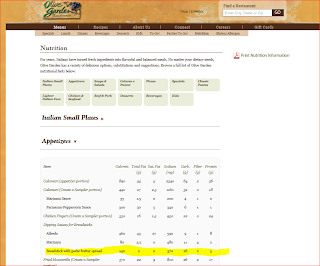I run a copycat recipe site: CopyCat Recipe Guide. There are lots of websites, as well as offline resources, that say they have copycat recipes. I am very proud of the product the CopyCat Recipe Guide writers produce - even more so after I compared one of our recipes to one produced by a prominent copycat recipe developer.
Todd Wilbur, the author of "Top Secret Restaurant Recipes" was featured on Good Morning America where he explained his clone of Olive Garden's breadstick recipe. You can read the article and watch the episode here. While these may be very good breadsticks, they are not the same those served at Olive Garden.
Here's the nutrition information from Olive Garden.
As you can see, each breadstick is 140 calories, with no saturated fat, 26 grams of carbohydrates, 2 grams of fiber, and 5 grams of protein.
This tells us right away that Wilbur's recipe can't be a clone- because he uses butter, which would add saturated fat. I input his recipe into a nutrition calculator, and got the following results:
His recipe is higher in calories, fat, saturated fat, carbohydrates, and sodium; and lower in fiber and protein. Since restaurant food is already fairly high in fat, sugar, and salt,
why should the "at-home" version be even higher? That doesn't make
sense.
Compare this to our recipe for copycat Olive Garden breadsticks at CopyCat Recipe Guide:
It's much closer to what Olive Garden reports for their breadsticks!
Our writers check their results against published nutrition information and ingredient lists wherever possible, as part of the process we use to get as close as possible to the actual dish. We know our readers are trying to duplicate the restaurant version at home - not just to make something similar. Sometimes, as with this recipe, it may take some creativity. Olive Garden probably uses a specific blend of flour that is not available to home cooks to get a higher protein and fiber content than you'd expect with regular bread flour. Adjusting all purpose flour with bran and vital wheat gluten produces the same results, with ingredients available in most supermarkets.
If there are recipes you'd like us to duplicate for you, please leave us a note on our Facebook page http://www.facebook.com/CopyCatRecipeGuide
Friday, February 15, 2013
Saturday, February 2, 2013
Scalloped Potatoes with Ham
This recipe tastes deceptively rich, despite containing no cheese, and being made with skim milk. The ham can be omitted if serving as a side dish.
Ingredients:
#Preheat the oven to 400 degrees.
#Bring 1 inch of water to a boil in a saucepan large enough to hold the potatoes and onions.
#Grease a 9x13 baking dish with butter.
#Add the parsley, onions, potatoes, and 2 teaspoons of salt to the boil water. Cover, reduce heat, and simmer for 5 minutes.
#Drain and set aside
#Melt the butter in a 4 cup glass measuring cup in the microwave.
#Whisk in the salt, pepper, paprika, and flour until smooth. Add the milk, and whisk until dissolved.
#Microwave the sauce on high power for 2 minutes, then whisk. Repeat once or twice more until white sauce has thickened.
#Place half of the potatoes and onions in the baking dish. Add the ham, and top with the remaining potatoes and onions.
#Pour the sauce over the top, stirring if needed to make sure it surrounds the potato-onion-ham mixture. Sprinkle more paprika on top if desired.
#Bake uncovered for 35 minutes until potatoes are tender and top is browned.
 |
Lori L. Stalteri via Flickr |
Ingredients:
- 2 tablespoons finely chopped fresh parsley
- 1 1/2 cups thinly sliced onions
- 4 1/2 cups thinly sliced potatoes
- 2 cups ham, diced (optional)
- 2 teaspoons salt
- 3 tablespoons butter, plus additional for greasing baking dish
- 7 teaspoons of flour
- 1 teaspoon salt
- 1/8 teaspoon pepper
- 1/8 teaspoon paprika, plus additional for sprinkling on top if desired
- 1 3/4 cups skim milk
#Preheat the oven to 400 degrees.
#Bring 1 inch of water to a boil in a saucepan large enough to hold the potatoes and onions.
#Grease a 9x13 baking dish with butter.
#Add the parsley, onions, potatoes, and 2 teaspoons of salt to the boil water. Cover, reduce heat, and simmer for 5 minutes.
#Drain and set aside
#Melt the butter in a 4 cup glass measuring cup in the microwave.
#Whisk in the salt, pepper, paprika, and flour until smooth. Add the milk, and whisk until dissolved.
#Microwave the sauce on high power for 2 minutes, then whisk. Repeat once or twice more until white sauce has thickened.
#Place half of the potatoes and onions in the baking dish. Add the ham, and top with the remaining potatoes and onions.
#Pour the sauce over the top, stirring if needed to make sure it surrounds the potato-onion-ham mixture. Sprinkle more paprika on top if desired.
#Bake uncovered for 35 minutes until potatoes are tender and top is browned.
Subscribe to:
Comments (Atom)
.jpg)



